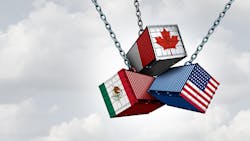With dizzying speed, the Trump administration earlier this month announced and then paused broad-based 25% tariffs on top U.S. trading partners Canada and Mexico, leaving both manufacturers and cross-border supply chains in a state of high anxiety. How the world will look at the end of the 30-day reprieve is anyone’s guess.
Seemingly lost in the furor of activity is the USMCA, or U.S.-Mexico-Canada Agreement. The USMCA updated NAFTA, the long-standing North America Free Trade Agreement, and took effect in 2020 during President Trump’ first time in office. Trump had been highly critical of NAFTA and made renegotiating the North America trade pact a priority in his first presidency.
Given the existence of the USMCA, shouldn’t it play a role in preventing a unilateral trade action by a partner to the pact? Is it a meaningless treaty in the face of these types of actions? Or is its role somewhere in between?
The short answers:
- Trump is sidestepping the deal on "security" grounds.
- Canada and Mexico can challenge Trump in court, but that could take years.
- The deal is up for review next year anyway, so this could be a preview of things to come.
More on Trump and Tariffs
President Donald Trump made imposing new, steep tariffs on trading partners a major part of his presidential run in 2023 and 2024.
Exceptions to USMCA: Essential Security
It may be that President Trump’s executive order imposing tariffs on Canada and Mexico is entirely in keeping with the language of the USMCA. The text of the free trade agreement includes an entire section devoted to exceptions, and language within the agreement allows parties to act in cases of “essential security,” noted Dan Swartz, international tax services principal at Crowe, in an email exchange.
He points out that in imposing the tariffs on Mexico and Canada, President Trump cited the “extraordinary threat imposed by illegal aliens and drugs” as a national emergency under the International Emergency Economic Powers Act.
Mechanisms to Resolve Disputes
Dispute resolution mechanisms are built into free trade agreements, including the USMCA. Canada or Mexico, or both, likely would have initiated the dispute resolution mechanism had the tariffs been imposed, Swartz wrote. (Side note: China, on which 10% additional duties were imposed—and not paused—has initiated a dispute complaint with the World Trade Organization.)
However, while free trade agreements like the USMCA include dispute mechanisms, the processes are slow, “especially taking into account the possibility of appeals,” said Gregory Husisian, partner at Foley & Lardner LLP, in emailed comments.
“Even if there is an adverse ruling and appellate ruling against the United States, it may be necessary for the foreign government to go to U.S. court to have the rulings followed, as happened when the United States lost a dispute involving antidumping and countervailing duties imposed on softwood lumber from Canada,” Husisian said. “Add it all up, and it easily can take years to reverse even executive actions that blatantly violate the USMCA.”
USMCA: ‘Meaningless and Beyond Repair’
The USMCA comes up for a legislated six-year review in 2026, with preparations by the three countries assuredly beginning in advance of that event. Christopher Sands of the Woodrow Wilson International Center for Scholars suggests this review provision could be the answer to avoiding an all-out trade war.
In a Feb. 1 article posted to the think tank’s website, Sands, director of the Wilson Center’s Canada Institute, proposed that the countries start the USMCA review process early and address the Trump administration’s concerns around security.
“Adding border security commitments to a revised USMCA would break new ground but not be unprecedented in principle,” he wrote.
Sands added a significant caveat to his position: It requires a cease fire.
“Canada and Mexico should not agree to review or renegotiate the USMCA early or ever unless the Trump administration sets aside the 25 percent tariff threat,” the article states. “It will require resolve and a united front by leaders in Canada and Mexico to hold to this precondition. But without it, the USMCA in its current form is meaningless and beyond repair.”
Foley & Lardner’s Husisian says all three countries have good reasons to keep the USMCA in effect: “The question is in what form?”
The USMCA won’t be ignored, he says, particularly by Canada and Mexico, which have the “most incentive to preserve it as a governing international trade instrument.”
That said, “all three countries have a shared interest in being strong competitors to Chinese companies.”
Husisian also pointed out that Canada and Mexico could decide individual bilateral agreements with the United States are the future, as dispute resolution may be simpler one on one. Canada and the U.S. had a bilateral free trade agreement before NAFTA, he noted.
About the Author
Jill Jusko
Bio: Jill Jusko is executive editor for IndustryWeek. She has been writing about manufacturing operations leadership for more than 20 years. Her coverage spotlights companies that are in pursuit of world-class results in quality, productivity, cost and other benchmarks by implementing the latest continuous improvement and lean/Six-Sigma strategies. Jill also coordinates IndustryWeek’s Best Plants Awards Program, which annually salutes the leading manufacturing facilities in North America.
Have a story idea? Send it to [email protected].

